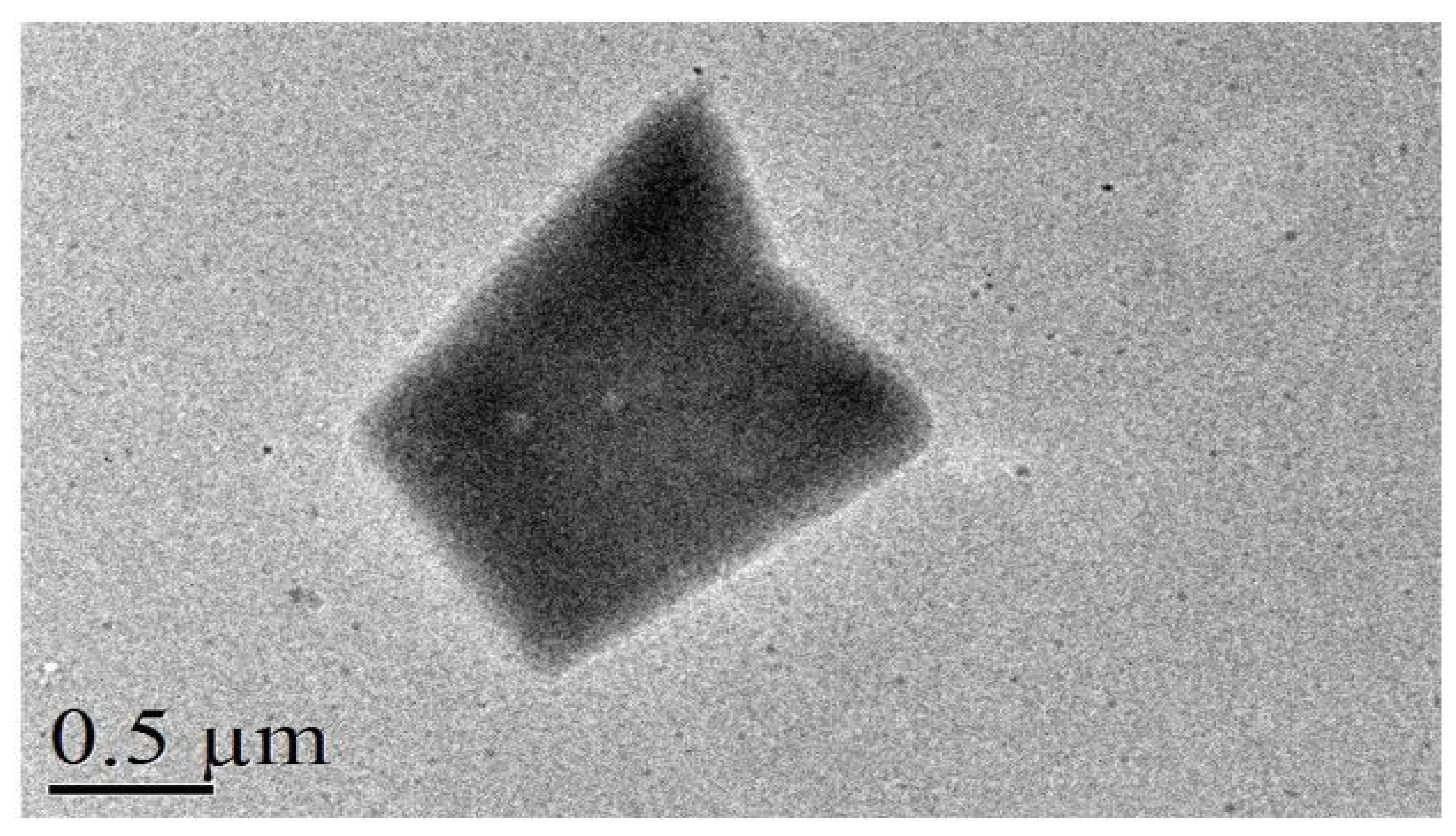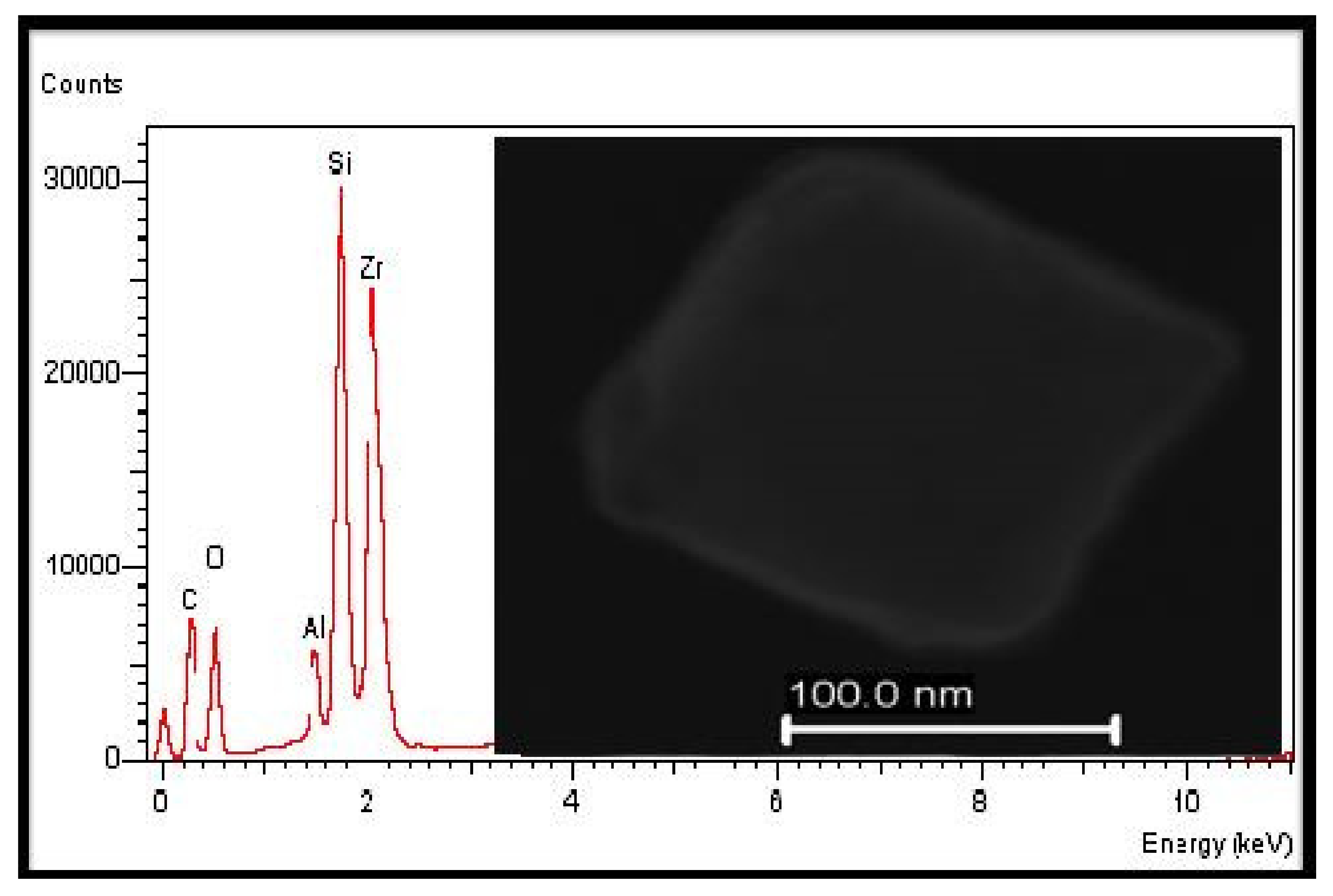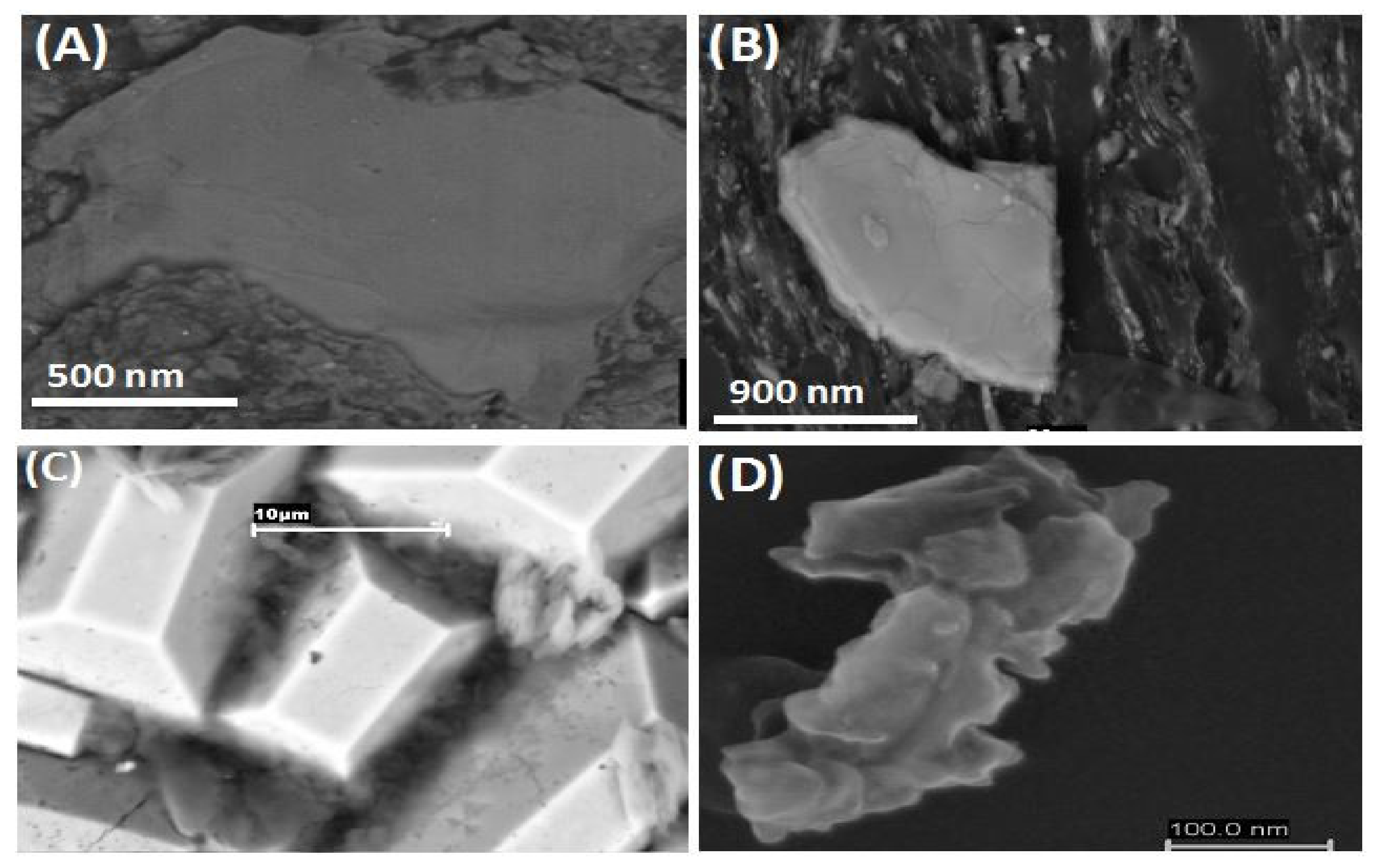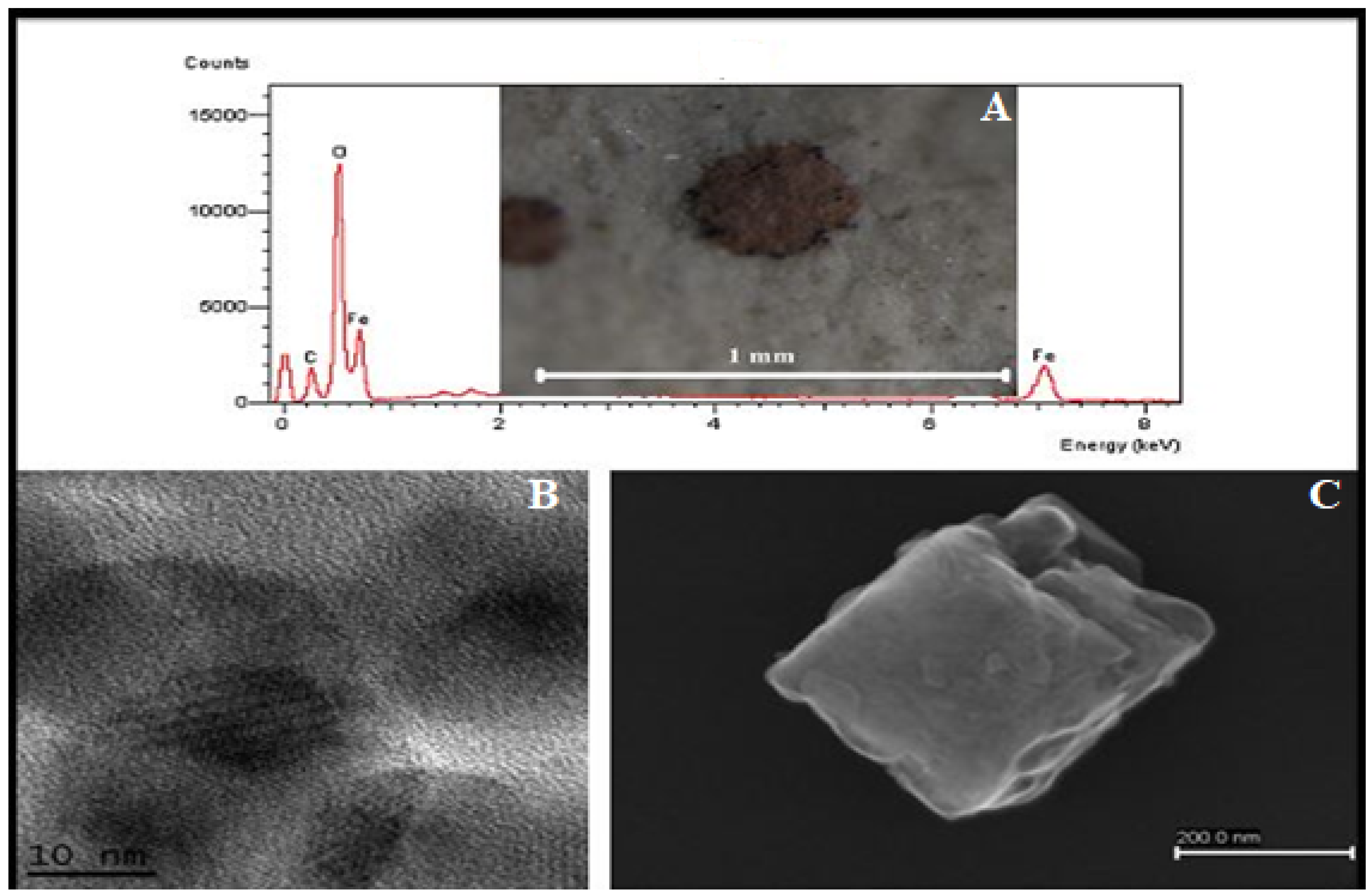Environmental Impacts of Coal Nanoparticles from Rehabilitated Mine Areas in Colombia
Abstract
:1. Introduction
2. Study Area
Social Context
3. Materials and Methods
3.1. Sampling Strategy
3.2. Analytical Methods
3.2.1. Mineralogical Phase Analysis
3.2.2. Morphological Analysis
3.2.3. Electron Beam Microscopy
3.2.4. Quantitative Mineral Phase Analysis
4. Results
Major Minerals and NPs
5. Discussion
6. Conclusions
Author Contributions
Funding
Institutional Review Board Statement
Informed Consent Statement
Data Availability Statement
Acknowledgments
Conflicts of Interest
References
- Watts, M. Empire of Oil: Capitalist Dispossession and the Scramble for Africa. Mon. Rev. 2006, 58, 1. [Google Scholar] [CrossRef]
- Healy, N.; Stephens, J.C.; Malin, S.A. Embodied Energy Injustices: Unveiling and Politicizing the Transboundary Harms of Fossil Fuel Extractivism and Fossil Fuel Supply Chains. Energy Res. Soc. Sci. 2019, 48, 219–234. [Google Scholar] [CrossRef]
- Moore, J.W. Sugar and the Expansion of the Early Modern World-Economy: Commodity Frontiers, Ecological Transformation, and Industrialization. Review 2000, 23, 409–433. [Google Scholar]
- Martinez-Alier, J.; Temper, L.; Del Bene, D.; Scheidel, A. Is There a Global Environmental Justice Movement? J. Peasant. Stud. 2016, 43, 731–755. [Google Scholar] [CrossRef]
- Bebbington, A.; Hinojosa, L.; Bebbington, D.H.; Burneo, M.L.; Warnaars, X. Contention and Ambiguity: Mining and the Possibilities of Development. Dev. Chang. 2008, 39, 887–914. [Google Scholar] [CrossRef] [Green Version]
- Quetame, C.; Sarmiento, G.A. Interpretacion del ambiente sedimentario delos carbones de la Formacion Guaduas en el sinclinal Checua Lenguazaque, a partir del analisis petrografico. Geol. Colomb. 2004, 29, 41–57. [Google Scholar]
- Bayona, G.; Jaramillo, C.; Rueda, M.; Pardo, A.; Christie, A.; Hernandez, G. Important Paleotectonic and Chronostratigraphic Considerations of the Late Paleocene in the Northernmost Andes as Constrained by Paleocene Rocks in the Cerrejon Coal Mine Guajira, Colombia. In Proceedings of the 3ra Convencion Tecnica de la ACGGP, Bogota, Colombia, June 2004; p. 10. Available online: https://www.researchgate.net/publication/267637823_Important_Paleotectonic_and_Chronostratigraphic_Considerations_of_the_Late_Paleocene_in_the_Northernmost_Andes_as_Constrained_by_Paleocene_Rocks_in_the_Cerrejon_Coal_Mine_Guajira_Colombia (accessed on 20 January 2020).
- Guzman, C.A. Condiciones de Depositacion de la Formacion Amaga Entre Amag_a y Angelopolis. Tesis de Posgrado en Ciencia y Tecnica del Carbon; Universidad Nacional de Colombia d Sede Medellín, Facultad de Minas: Medellín, Colombia, 1991; p. 213. [Google Scholar]
- Lopez, I.C.; Ward, C.R. Composition and mode of occurrence of mineral matter in some Colombian coals. Int. J. Coal Geol. 2008, 73, 3–18. [Google Scholar] [CrossRef]
- Civeira, M.S.; Ramos, C.G.; Oliveira, M.L.; Kautzmann, R.M.; Taffarel, S.R.; Teixeira, E.C.; Silva, L.F. Nano-Mineralogy of Suspended Sediment During the Beginning of Coal Rejects Spill. Chemosphere 2016, 145, 142–147. [Google Scholar] [CrossRef]
- Nordin, A.P.; Da Silva, J.; De Souza, C.T.; Niekraszewicz, L.A.; Dias, J.F.; Da Boit, K.; Oliveira, M.L.; Grivicich, I.; Garcia, A.L.H.; Oliveira, L.F.S. In Vitro Genotoxic Effect of Secondary Minerals Crystallized in Rocks from Coal Mine Drainage. J. Hazard. Mater. 2018, 346, 263–272. [Google Scholar] [CrossRef]
- Akinyemi, S.A.; Gitari, W.M.; Thobakgale, R.; Petrik, L.F.; Nyakuma, B.B.; Hower, J.C.; Ward, C.R.; Oliveira, M.L.S.; Silva, L.F.O. Geochemical Fractionation of Hazardous Elements in Fresh and Drilled Weathered South African Coal Fly Ashes. Environ. Geochem. Health 2020, 42, 2771–2788. [Google Scholar] [CrossRef]
- Cooke, J.; Johnson, M. Ecological Restoration of Land with Particular Reference to the Mining of Metals and Industrial Minerals: A Review of Theory and Practice. Environ. Rev. 2002, 10, 41–71. [Google Scholar] [CrossRef] [Green Version]
- Ribeiro, J.; Flores, D.; Ward, C.R.; Silva, L.F. Identification of Nanominerals and Nanoparticles in Burning Coal Waste Piles from Portugal. Sci. Total Environ. 2010, 408, 6032–6041. [Google Scholar] [CrossRef]
- Barliza, J.C.; Rodríguez, O.B.; Peláez, J.D.L.; Chávez, L.F. Planted forests for open coal mine spoils rehabilitation in Colombian drylands: Contributions of fine litterfall through an age chronosequence. Ecol. Eng. 2019, 138, 180–187. [Google Scholar] [CrossRef]
- IUSS Working Group Wrb. World Reference Base for Soil Resources 2014, Update 2015 International Soil Classification System for Naming Soils and Creating Legends for Soil Maps; International Union of Soil Sciences (IUSS): Wien, Austria, 2015. [Google Scholar]
- Pandey, Y.; Sangita Tare, V. Utilization of Coal Mixed Waste Aggregates Available at Thermal Power Plants for GSB and Asphalt Mixtures. Procedia Eng. 2016, 143, 170–177. [Google Scholar] [CrossRef] [Green Version]
- Silva, L.F.O.; Pinto, D.; Lima, B.D. Implications of iron nanoparticles in spontaneous coal combustion and the effects on climatic variables. Chemosphere 2020, 254, 126814. [Google Scholar] [CrossRef]
- Rabha, S.; Saikia, B.K. Nanominerals and Nanoparticles in coal and coal Residues: Implications for Human Health Effects. In Proceedings of the Recent Trends in Environmental Responsive Chemical Processes (RTERCP-2017), Golaghat, India, 22–23 September 2017. [Google Scholar]
- Akinyemi, S.A.; Gitari, W.M.; Petrik, L.F.; Nyakuma, B.B.; Hower, J.C.; Ward, C.R.; Oliveira, M.L.S.; Silva, L.F.O. Environmental Evaluation and Nano-Mineralogical Study of Fresh and Unsaturated Weathered Coal Fly Ashes. Sci. Environ. 2019, 663, 177–188. [Google Scholar] [CrossRef]
- Silva, L.; Querol, X.; Da Boit, K.; De Vallejuelo, S.F.-O.; Madariaga, J. Brazilian Coal Mining Residues and Sulphide Oxidation by Fenton’s Reaction: An Accelerated Weathering Procedure to Evaluate Possible Environmental Impact. J. Hazard. Mater. 2011, 186, 516–525. [Google Scholar] [CrossRef] [Green Version]
- Saikia, B.K.; Saikia, J.; Rabha, S.; Silva, L.F.; Finkelman, R. Ambient Nanoparticles/Nanominerals and Hazardous Elements from Coal Combustion Activity: Implications on Energy Challenges and Health Hazards. Geosci. Front. 2018, 9, 863–875. [Google Scholar] [CrossRef]
- Oliveira, M.L.; Da Boit, K.; Schneider, I.L.; Teixeira, E.C.; Borrero, T.J.C.; Silva, L.F. Study of Coal Cleaning Rejects by Fib and Sample Preparation for Hr-Tem: Mineral Surface Chemistry and Nanoparticle-Aggregation Control for Health Studies. J. Clean. Prod. 2018, 188, 662–669. [Google Scholar] [CrossRef]
- Silva, L.F.; Izquierdo, M.; Querol, X.; Finkelman, R.B.; Oliveira, M.L.; Wollenschlager, M.; Towler, M.; Pérez-López, R.; Macias, F. Leaching of Potential Hazardous Elements of Coal Cleaning Rejects. Environ. Monit. Assess. 2011, 175, 109–126. [Google Scholar] [CrossRef]
- Carmona-García, U.; Cardona-Trujillo, H.; Restrepo-Tarquino, I. Gestión Ambiental, Sostenibilidad Y Competitividad Minera. Contextualización De La Situación Y Retos De Un Enfoque a Través Del Análisis Del Ciclo De Vida. Dyna 2017, 84, 50–58. [Google Scholar] [CrossRef]
- Minminas. Análisis Delcomportamiento Del Pib Minero Segundo Trimestre De. 2017. Available online: https://bit.ly/2LuwYYH (accessed on 20 January 2020).
- Oei, P.-Y.; Mendelevitch, R. Prospects for Steam Coal Exporters in the Era of Climate Policies: A Case Study of Colombia. Clim. Policy 2019, 19, 73–91. [Google Scholar] [CrossRef] [Green Version]
- Torres, A.; Rocha, J.; Melo, D.; Peña, R. El Carbón En Colombia¿ Quién Gana, Quién Pierde? Minería, Comercio Global Y Cambio Climático; Centro de Estudios para la Justicia Social ‘Tierra Digna’: Bogotá, Colombia, 2015. [Google Scholar]
- Oliveira, M.L.; Pinto, D.; Tutikian, B.F.; Da Boit, K.; Saikia, B.K.; Silva, L.F. Pollution from Uncontrolled Coal Fires: Continuous Gaseous Emissions and Nanoparticles from Coal Mines. J. Clean. Prod. 2019, 215, 1140–1148. [Google Scholar] [CrossRef]
- Gregow, K.; Syd, F. As Black as Coal: Business and Human Rights with Focus on Coal Mining in Colombia. Stockholm, Sweden: Forum Syd. 2016. Available online: https://bit.ly/2G9i7io (accessed on 20 January 2020).
- Guo, Q.; Littke, R.; Zieger, L. Petrographical and Geochemical Characterization of Sub-Bituminous Coals from Mines in the Cesar-Ranchería Basin, Colombia. Int. J. Coal Geol. 2018, 191, 66–79. [Google Scholar] [CrossRef]
- Baquero, M.; Montes, C.; Bayona, G.A. Attribute-Based Processing of Lineament Data: An Example from Cesar-Rancheria and Neighbor Provinces in Colombia. In Earth Resources and Environmental Remote Sensing/GIS Applications V; International Society for Optics and Photonics: Bellingham, DC, USA, 2014; Volume 9245, pp. 70–77. [Google Scholar]
- Sanchez, J.; Mann, P. Integrated Structural and Basinal Analysis of the Cesar–Rancheria Basin, Colombia: Implications for Its Tectonic History and Petroleum Systems. In Memoir 108: Petroleum Geology and Potential of the Colombian Caribbean Margin; American Association of Petroleum Geologists: Tulsa, OK, USA, 2015. [Google Scholar]
- Mosquera-Vivas, C.S.; Hansen, E.W.; García-Santos, G.; Obregón-Neira, N.; Celis-Ossa, R.E.; González-Murillo, C.A.; Juraske, R.; Hellweg, S.; Guerrero-Dallos, J.A. The Effect of the Soil Properties on Adsorption, Single-Point Desorption, and Degradation of Chlorpyrifos in Two Agricultural Soil Profiles from Colombia. Soil Sci. 2016, 181, 446–456. [Google Scholar] [CrossRef]
- Sandoval, L.E.; Marín, M.; Almanza, A.M. Explotación De Recursos Naturales Y Conflicto En Colombia. Rev. Econ. Inst. 2017, 19, 201–225. [Google Scholar] [CrossRef] [Green Version]
- Pérez Rincón, M.A. Conflictos Ambientales En Colombia: Inventario, Caracterización Y Análisis. In Estrategia de Manejo Ambiental de la Zona Media y Baja de la Subcuenca del Río Pance; Instituto CINARA: Cali, Colombia, 2014. [Google Scholar]
- Cardoso, A. Behind the Life Cycle of Coal: Socio-Environmental Liabilities of Coal Mining in Cesar, Colombia. Ecol. Econ. 2015, 120, 71–82. [Google Scholar] [CrossRef]
- Cardoso, A. Valuation Languages Along the Coal Chain from Colombia to the Netherlands and to Turkey. Ecol. Econ. 2018, 146, 44–59. [Google Scholar] [CrossRef]
- Republic of Colombia. Republic of Colombia Colombia’s Constitution of 1991 with Amendments through 2005; Republic of Colombia: Bogota, Colombia, 1991.
- Henriksen, J.B. Research on Best Practices for the Implementation of the Principles of Ilo Convention; International Labour Organization (ILO): Geneva, Switzerland, 2008. [Google Scholar]
- Chomsky, A. Colombia’s Other Displacements. ReVista 2017, 16, 35. [Google Scholar]
- Vargas, F. Minería, Conflicto Armado Y Despojo De Tierras: Impactos, Desafíos Y Posibles Soluciones Jurídicas. In Minería en Colombia. Fundamentos Para Superar El Modelo Extractivista; Universidad Externado de Colombia: Bogota, Colombia, 2013; pp. 57–88. [Google Scholar]
- Abcolombia; CAFOD; Christian Aid; Oxfam GB; Sciaf; Trócaire. Regalándolo Todo: Las Consecuencias De Una Política Minera No Sostenible En Colombia. Tomado de 2012. Available online: http://www.abcolombia.org.uk/downloads (accessed on 22 February 2020).
- Rudas, G.; Hawkins, D.; Sánchez, S.T. La Minería De Carbón a Gran Escala En Colombia: Impactos Económicos, Sociales, Laborales, Ambientales Y Territoriales; Friedrich-Ebert-Stiftung en Colombia: Bogota, Colombia, 2014. [Google Scholar]
- EIA. Colombia: International Energy Data and Analysis; US Energy Information Administration: Washington, DC, USA, 2015.
- Ramos, C.G.; Querol, X.; Dalmora, A.C.; De Jesus Pires, K.C.; Schneider, I.A.H.; Oliveira, L.F.S.; Kautzmann, R.M. Evaluation of the Potential of Volcanic Rock Waste from Southern Brazil as a Natural Soil Fertilizer. J. Clean. Prod. 2017, 142, 2700–2706. [Google Scholar] [CrossRef]
- Quispe, D.; Pérez-López, R.; Silva, L.F.; Nieto, J.M. Changes in Mobility of Hazardous Elements During Coal Combustion in Santa Catarina Power Plant (Brazil). Fuel 2012, 94, 495–503. [Google Scholar] [CrossRef]
- Silva, L.F.; Wollenschlager, M.; Oliveira, M.L. A Preliminary Study of Coal Mining Drainage and Environmental Health in the Santa Catarina Region, Brazil. Environ. Geochem. Health 2011, 33, 55–65. [Google Scholar] [CrossRef]
- Mimba, M.E.; Ohba, T.; Fils, S.C.N.; Nforba, M.T.; Numanami, N.; Bafon, T.G.; Aka, F.T.; Suh, C.E. Regional Geochemical Baseline Concentration of Potentially Toxic Trace Metals in the Mineralized Lom Basin, East Cameroon: A Tool for Contamination Assessment. Geochem. Trans. 2018, 19, 11. [Google Scholar] [CrossRef] [Green Version]
- Kříbek, B.; Sýkorová, I.; Veselovský, F.; Laufek, F.; Malec, J.; Knésl, I.; Majer, V. Trace Element Geochemistry of Self-Burning and Weathering of a Mineralized Coal Waste Dump: The Novátor Mine, Czech Republic. Int. J. Coal Geol. 2017, 173, 158–175. [Google Scholar] [CrossRef]
- Barboza, L.G.A.; Vieira, L.R.; Guilhermino, L. Single and Combined Effects of Microplastics and Mercuron Juveniles of the European Seabass (Dicentrarchus Labrax): Changes in Behavioural Responses and Reduction of Swimming Velocity and Resistance Time. Environ. Pollut. 2018, 236, 1014–1019. [Google Scholar] [CrossRef]
- Zeppilli, D.; Sarrazin, J.; Leduc, D.; Arbizu, P.M.; Fontaneto, D.; Fontanier, C.; Gooday, A.J.; Kristensen, R.M.; Ivanenko, V.N.; Sørensen, M.V. Is the Meiofauna a Good Indicator for Climate Change and Anthropogenic Impacts? Mar. Biodivers. 2015, 45, 505–535. [Google Scholar] [CrossRef] [Green Version]
- Riera, R.; Tuya, F.; Sacramento, A.; Ramos, E.; Monterroso, Ó.; Rodríguez, M. Influence of the Combined Disposal of Sewage and Brine on Meiofauna. Cienc. Mar. 2013, 39, 15–27. [Google Scholar] [CrossRef] [Green Version]
- Bertocci, I.; Dell’anno, A.; Musco, L.; Gambi, C.; Saggiomo, V.; Cannavacciuolo, M.; Martire, M.L.; Passarelli, A.; Zazo, G.; Danovaro, R. Multiple Human Pressures in Coastal Habitats: Variation of Meiofaunal Assemblages Associated with Sewage Discharge in a Post-Industrial Area. Sci. Total Environ. 2019, 655, 1218–1231. [Google Scholar] [CrossRef]
- Silva, L.F.; Daboit, K.; Sampaio, C.H.; Jasper, A.; Andrade, M.L.; Kostova, I.J.; Waanders, F.B.; Henke, K.R.; Hower, J.C. The Occurrence of Hazardous Volatile Elements and Nanoparticles in Bulgarian Coal Fly Ashes and the Effect on Human Health Exposure. Sci. Total Environ. 2012, 416, 513–526. [Google Scholar] [CrossRef]
- Turci, F.; Pavan, C.; Leinardi, R.; Tomatis, M.; Pastero, L.; Garry, D.; Anguissola, S.; Lison, D.; Fubini, B. Revisiting the Paradigm of Silica Pathogenicity with Synthetic Quartz Crystals: The Role of Crystallinity and Surface Disorder. Part. Fibre Toxicol. 2015, 13, 32. [Google Scholar] [CrossRef] [Green Version]
- Maher, B.A.; Ahmed, I.A.; Karloukovski, V.; Maclaren, D.A.; Foulds, P.G.; Allsop, D.; Mann, D.M.; Torres-Jardón, R.; Calderon-Garciduenas, L. Magnetite Pollution Nanoparticles in the Human Brain. Proc. Natl. Acad. Sci. USA 2016, 113, 10797–10801. [Google Scholar] [CrossRef] [PubMed] [Green Version]
- Espitia-Perez, L.; Da Silva, J.; Brango, H.; Espitia-Perez, P.; Pastor-Sierra, K.; Salcedo-Arteaga, S.; De Souza, C.T.; Dias, J.F.; Hoyos-Giraldo, L.S.; Gomez-Perez, M. Genetic Damage in Environmentally Exposed Populations to Open-Pit Coal Mining Residues: Analysis of Buccal Micronucleus Cytome (Bmn-Cyt) Assay and Alkaline, Endo Iii and Fpg High-Throughput Comet Assay. Mutat. Res./Genet. Toxicol. Environ. Mutagenes. 2018, 836, 24–35. [Google Scholar] [CrossRef] [PubMed]
- Shashikala, R.; Indira, A.; Manjunath, G. Role of Micronucleus in Oral Exfoliative Cytology. J. Pharm. Bioallied Sci. 2015, 7 (Suppl. 2), S409. [Google Scholar] [PubMed]
- Holland, N.; Bolognesi, C.; Kirsch-Volders, M.; Bonassi, S.; Zeiger, E.; Knasmueller, S.; Fenech, M. The Micronucleus Assay in Human Buccal Cells as a Tool for Biomonitoring DNA Damage: The Humn Project Perspective on Current Status and Knowledge Gaps. Mutat. Res./Rev. Mutat. Res. 2008, 659, 93–108. [Google Scholar] [CrossRef]
- Tanaka, T.; Ishigamori, R. Understanding Carcinogenesis for Fighting Oral Cancer. J. Oncol. 2011, 2011, 603740. [Google Scholar] [CrossRef]
- Sánchez-Peña, N.E.; Narváez-Semanate, J.L.; Pabón-Patiño, D.; Fernández-Mera, J.E.; Oliveira, M.L.; Da Boit, K.; Tutikian, B.F.; Crissien, T.J.; Pinto, D.C.; Serrano, I.D. Chemical and Nano-Mineralogical Study for Determining Potential Uses of Legal Colombian Gold Mine Sludge: Experimental Evidence. Chemosphere 2018, 191, 1048–1055. [Google Scholar] [CrossRef]
- Kumar, H.; Ahmad, I.; Dutta, P.K. In-Vitro Toxicity Induced by Quartz Nanoparticles: Role of Er Stress. Toxicology 2018, 404, 1–9. [Google Scholar]






Publisher’s Note: MDPI stays neutral with regard to jurisdictional claims in published maps and institutional affiliations. |
© 2022 by the authors. Licensee MDPI, Basel, Switzerland. This article is an open access article distributed under the terms and conditions of the Creative Commons Attribution (CC BY) license (https://creativecommons.org/licenses/by/4.0/).
Share and Cite
Oliveira, M.L.S.; Akinyemi, S.A.; Nyakuma, B.B.; Dotto, G.L. Environmental Impacts of Coal Nanoparticles from Rehabilitated Mine Areas in Colombia. Sustainability 2022, 14, 4544. https://doi.org/10.3390/su14084544
Oliveira MLS, Akinyemi SA, Nyakuma BB, Dotto GL. Environmental Impacts of Coal Nanoparticles from Rehabilitated Mine Areas in Colombia. Sustainability. 2022; 14(8):4544. https://doi.org/10.3390/su14084544
Chicago/Turabian StyleOliveira, Marcos L. S., Segun A. Akinyemi, Bemgba B. Nyakuma, and Guilherme L. Dotto. 2022. "Environmental Impacts of Coal Nanoparticles from Rehabilitated Mine Areas in Colombia" Sustainability 14, no. 8: 4544. https://doi.org/10.3390/su14084544






